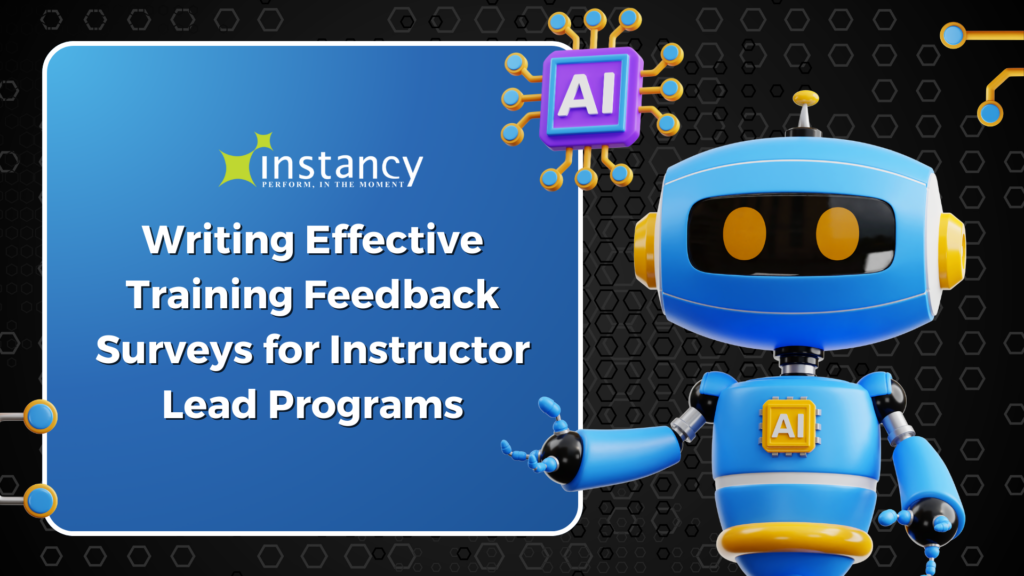Importance of Training Feedback
Feedback fulfills a crucial role in instructor-led training program effectiveness. Actively seeking participant feedback provides organizations valuable insights to refine programs and enhance learning experiences. This section explores the role of feedback in instructor-led training and the benefits of effective training feedback surveys.
The Role of Feedback in Instructor-Led Training Programs
Feedback serves as a powerful enhancement tool in instructor-led training. It furnishes trainers and organizations with valuable information on content and delivery strengths and weaknesses. By collecting participant feedback, trainers can gauge impact, identify improvement areas, and make data-driven decisions to refine strategies.
Instructor-led training often involves direct trainer-participant interaction, creating an ideal feedback environment. Participants can provide insights on content clarity, instructional technique effectiveness, and material relevance. This feedback loop fosters continuous improvement and helps trainers tailor approaches to meet participant needs.
Benefits of Effective Training Feedback Surveys
Utilizing effective training feedback surveys offers benefits for both trainers and organizations. Surveys provide a structured, systematic feedback collection approach, ensuring comprehensive training evaluation.
Surveys give trainers valuable insights to identify effectiveness and improvements for informed enhancement decisions. Participant engagement in the feedback process empowers them to contribute to training optimization. Their opinions are valued, increasing engagement and honesty.
Surveys help evaluate training’s impact on learning outcomes. This enables the assessment of content and delivery effectiveness for refinement. Collecting quantitative and qualitative data supports the analysis of trends and patterns for improvement identification and data-driven decision-making.
Recognizing feedback’s role and implementing effective surveys, organizations can continuously improve instructor-led training to meet participant needs and expectations. Further specific evaluation questions and design details are explored in our training evaluation questions article.
Designing Effective Training Feedback Surveys

To gather valuable instructor-led training feedback, an effective survey design is crucial. Two key considerations are identifying training objectives/goals and determining the survey scope.
Identifying Training Objectives and Goals:
Before survey creation, clearly defining training objectives and goals is essential for alignment. This ensures the survey focuses on evaluating the specific outcomes and learning objectives.
Consider the desired outcomes and the skills or knowledge participants should acquire. Identify key areas for the survey to assess effectiveness. Topics, delivery methods, instructor effectiveness, and satisfaction may be included.
Aligning the questions with objectives and goals enables targeted feedback directly related to success. Our training evaluation questions article provides further guidance on creating effective questions.
Determining the Survey Scope:
Determining the survey scope involves defining the specific aspects requiring feedback. Consider participant time constraints and focus on the most critical areas aligning with the objectives.
Start by identifying key areas needing input, including content, instruction, materials, and satisfaction. Avoid an excessively long survey. Instead, concentrate on the crucial elements tied to the goals.
A focused, manageable survey encourages thoughtful, meaningful responses for actionable insight identification and informed decisions to enhance the training program. Additional details on measurement and questions are in our measuring training effectiveness and training evaluation questions articles.
Careful design aligned to objectives and appropriately scoped gathers valuable insights to evaluate and enhance instructor-led training experiences.

Choosing the Right Survey Format:
The right survey format is key to gathering meaningful, actionable instructor-led training feedback. Different formats offer unique advantages for varied response types. Three commonly used formats are Likert scale, multiple choice, and open-ended questions.
1. Likert Scale Surveys
Likert scales are popular due to their simplicity and effectiveness in measuring opinions and attitudes. Participants rate agreement with statements on a scale, typically 1-5 or 1-7.
Quantitative analysis of Likert data provides consensus insights to identify trends and patterns, facilitating overall effectiveness assessment. Here is an example:
Please rate the overall training material quality:
1 – Poor
2 – Fair
3 – Average
4 – Good
5 – Excellent
2. Multiple Choice Surveys
Multiple choice presents predefined choices for participants to select. This is useful for gathering specific information or when clear response categories exist.
Structured options allow easy selection of the best response. The quantitative analysis identifies areas needing improvement. Here is an example:
Which training module was most helpful?
- Module 1
- Module 2
- Module 3
- Module 4
Open-ended questions enable detailed qualitative responses in participants’ own words. They provide suggestions, improvement areas, and specific issue insights potentially missed by closed-ended questions.
While more effortful to analyze, these responses yield a deeper understanding of experiences to inform training improvements. Here is an example:
Please share any additional comments or suggestions regarding the training.
Blending these formats provides comprehensive quantitative and qualitative feedback for a holistic view to identify areas for improvement in instructor-led training programs. More example questions are available in our training evaluation questions article.
Crafting Clear and Specific Questions:
Crafting clear, specific questions provides valuable instructor-led training feedback insights. Avoiding bias, using neutral language, and ensuring clarity gather meaningful responses to enhance effectiveness.
Avoiding Bias in Survey Questions:
Ensuring objectivity requires avoiding bias in questions, which can skew results. Use unbiased language not leading to specific answers. Avoid emotionally charged or leading words swaying opinions. Allow individuals to share thoughts and experiences genuinely.
Using Neutral Language:
Neutral language maintains objectivity. Non-judgmental, impersonal wording ensures understanding without assumptions. Avoid terms triggering emotional responses or influencing opinions.
Ensuring Clarity and Understanding:
Clarity is key for accurate responses. Concise, jargon-free questions avoid confusion. Eliminate vague phrases with multiple interpretations. Use examples to provide context when needed. Clarity enables meaningful feedback for informed decisions.
Well-crafted, specific questions encourage honest, valuable responses to drive training program improvements. Sample evaluation questions are available in our training evaluation questions article.
Gathering Actionable Feedback:
Gathering specific, honest, constructive feedback provides actionable insights. Strategies include asking for examples/scenarios, encouraging candidness, and providing open comment space.
Asking for Specific Examples and Scenarios:
Requesting concrete examples and scenarios pinpoint areas for improvement with valuable context. Rather than general questions, ask for application examples or cases where training could be more effective. Tangible examples provide insights into strengths and weaknesses.
Encouraging Honest and Constructive Feedback

Assuring confidentiality encourages honest, constructive responses by creating a safe space. Balanced scale questions allow the free expression of opinions. However, open-ended questions are crucial for elaboration and additional insights. Feedback helps drive improvements.
Providing Space for Additional Comments
Supplementary comment space allows participants to share additional relevant insights not captured in predefined questions, providing a comprehensive view of experiences and suggestions. Look for themes to identify areas for improvement.
Implementing these strategies furnishes actionable feedback to continuously improve instructor-led training. Further analysis and utilization details are explored in the next section.
Analyzing and Utilizing Feedback
Once collected, the next steps are analyzing and utilizing survey feedback for improvement. This involves organizing data, identifying trends and patterns, and incorporating insights into enhancements.
Organizing and Analyzing Survey Data
Structured data organization enables effective analysis. Categorize responses by question and identify themes. Summarize results in a table highlighting areas of strength and needing attention. For example:
This summarizes feedback and identifies focus areas based on participant consensus.
Identifying Trends and Patterns
Analyze data for recurring comments or suggestions indicating potential improvements. If multiple participants mention difficult training materials, this signals an area to address. Prioritizing these trends focuses efforts on targeted enhancements.
Incorporating Feedback into Training Improvements
The goal is to utilize feedback to improve training. Consider it when designing future sessions or revising existing programs. Revise unclear content or add real-world examples if suggested. Feedback enables growth through active listening and thoughtful incorporation.
Effective analysis provides data-driven decision-making for continuous improvement and impactful instructor-led training experiences. Additional insights are available in our articles on training evaluation questions and measuring effectiveness.
Well-designed training feedback surveys provide actionable insights to enhance instructor-led programs. Aligning questions with objectives, incorporating varied formats, and gathering honest feedback yields comprehensive data to identify areas for improvement. Thorough analysis and incorporation of feedback fosters continuous optimization. Organizations can leverage surveys to refine training for maximum effectiveness consistently.
Writing Effective Training Feedback Surveys for Instructor-Led Programs

The success of any training program hinges on its ability to evolve and adapt based on learner needs and experiences. Feedback from participants provides a crucial avenue for understanding these needs and making informed improvements. For instructor-led programs, crafting effective training feedback surveys is essential to gather valuable insights. Instancy’s online survey authoring tool offers a versatile solution that empowers trainers to create, manage, and analyse web-based feedback forms, ultimately enhancing the quality of learning experiences.
Harnessing the Power of Instancy's Survey Editor
In instructor-led training, the Instancy Survey Editor is a potent tool for gathering user feedback and catalysing improvements. This module not only streamlines the process of creating and delivering surveys but also aids in managing the received data. By linking these web-based feedback forms to both eLearning and traditional classroom training programs, Instancy facilitates seamless integration of evaluation into diverse learning environments.
The Array of Survey Question Types
The cornerstone of any effective feedback survey is the composition of relevant and insightful questions. Instancy Survey Editor offers an extensive selection of question types, ranging from the fundamental to the nuanced. Beyond the conventional assessment question types, such as single select, multiple select, short text response, and true or false, Instancy incorporates matrix question types.
These matrix questions allow for the inclusion of Likert scale inquiries, designed to group questions and yield ‘agree’ or ‘disagree’ responses. This multiplicity of question types ensures that trainers can solicit a comprehensive range of feedback, capturing quantitative and qualitative data for a more holistic assessment.
Efficiency Through Customization and Integration
Understanding that trainers’ time is invaluable, Instancy has integrated time-saving features into their Survey Editor. Trainers can leverage the bulk importing feature to import batches of questions from pre-defined MS Excel spreadsheets swiftly. This dynamic approach streamlines the creation process, allowing trainers to rearrange questions, integrate media elements, and refine text content within the survey editor.
The platform’s commitment to customization extends beyond question composition. Trainers can seamlessly apply themes to surveys, aligning them with branding elements like logos and colors. This customization is independent of survey content, enabling trainers to change themes without affecting survey questions or necessitating content re-publication.
Creating Connections through Linking Surveys
Incorporating feedback surveys into the broader learning journey is integral to their effectiveness. Instancy recognizes this by enabling trainers to link surveys with various learning paths and events. This capability facilitates targeted feedback collection based on specific contexts, ensuring collected insights are directly relevant and actionable.
Data-Driven Decisions through Informative Reporting
At the heart of the Instancy Survey Editor lies its robust reporting and analysis functionality. Trainers can generate summary reports post-survey completion, providing an overview of total and user-specific responses to each question. These insights empower trainers to make data-driven decisions, identifying areas of strength and opportunities for growth within their instructor-led programs.
In essence, crafting effective training feedback surveys is pivotal in fostering continuous improvement in instructor-led programs. Instancy’s Survey Editor offers a comprehensive solution, empowering trainers to gather, manage, and analyse user feedback effortlessly. Through diverse question types, time-efficient importing processes, customization options, and insightful reporting, trainers can capitalize on the wealth of data available, driving meaningful enhancements in the learning experience. Instancy’s dedication to simplifying the evaluation process underscores their commitment to facilitating effective learning and participant engagement.
Ready to Enhance Your Training Evaluation Process?
Unlock the potential of your training programs with Instancy’s powerful Survey Editor integrated within the Learning Management System. Streamline your feedback collection, analysis, and improvement efforts. Take your training to the next level by exploring Instancy’s Survey Editor today!



